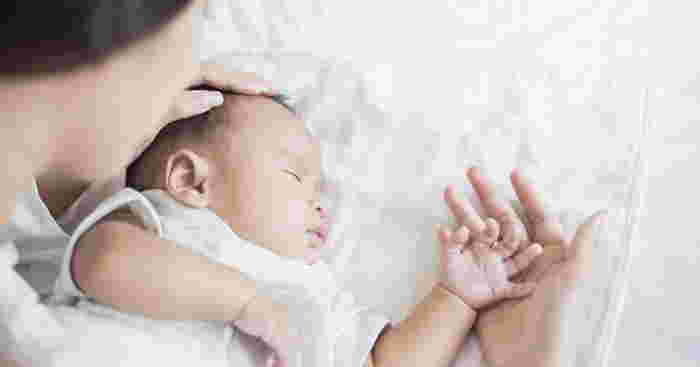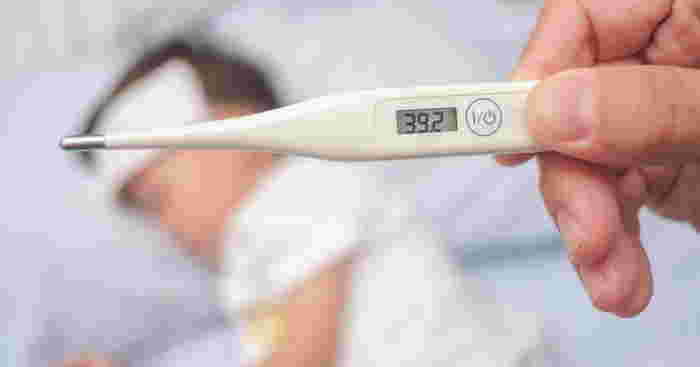Doctor Reveals Most Accurate Way to Take Your Child’s Temperature

One mistake parents fall into is focusing too much on the temperature by checking it way too many times—and not on how sick their child is.
Digital, infrared, in the ear, under the arm, on the forehead, or in the mouth… What type of thermometer is best to use at home? Sydney-based GP Dr Sam Hay explains how to measure your sick child’s temperature accurately at home.
Probably the best part of being a GP is working long term in the same community. As the years go on, we care for kids as they grow into young adults. We care for them through their pregnancies, then help them through all the good and bad bits of being a parent.
And being a parent can be tough, especially when your kids are sick.
But one of the most rewarding jobs as a doctor is helping parents learn how to care for their sick kids.
Every parent starts out as the dreaded helicopter parent. It’s ingrained in our DNA to be nurturing and protective, and be overly cautious when babies are young. But it’s also imperative for parents to learn, to understand where the thresholds are for just ‘watching and waiting’, and when it’s time to get some help.
And the one symptom sure to create the most amount of confusion is a fever. But I reckon the biggest factor is not the fever itself, but confusion surrounding how to even measure a child’s temperature in the first place! Here’s my expert guide for measuring temperatures, so you can develop more confidence managing a fever.

A hot baby is always worrying for parents. | Image source: iStock
But first, the top five things you need to know about a ‘fever’
- A fever refers to an increase in the body’s temperature.
- Fever is just a symptom. It’s not a disease in itself.
- Fever generally arises when the body’s immune system gets triggered, most commonly by an infection.
- Being ‘just a symptom’, the most important issue is how ‘sick’ your child is – so focus on how they’re behaving, not just their temperature.
- Rising temperatures don’t always correspond to worsening illness. And kids can be bloody sick with normal or low temperatures.
So when do we say it’s a fever? Kids come in all shapes and sizes, and that means they way they respond to illnesses varies widely as well. And that includes their body temperature.
As a good rule of thumb, any measured temperature over 38 for babies under about three months, and over 38.5 for older babies, kids and adults, qualifies as a fever.
How do you measure temperature properly?
No sleep-deprived parent wants to end up in emergency in the middle of the night, waiting for hours, only to find out that ‘raging temperature’ was merely a false reading. So as a start, to pass on the two key lessons I learnt in med school – always read the instructions, and always check the batteries.
Firstly make sure your kids aren’t just simply overheating. Grandma always told us to rug up when we’re sick. And that’s exactly what every parent does. Kids end up with five jumpers, three coats, and seven blankets on them! Children, especially babies, are terrible at regulating their body temperature, and with too many layers on, they’ll simply cook. So always have a good think about whether you might just need to cool them off a bit before you check (and re-check) their temperature.
It’s a good idea to check your own temperature first, even your partner’s, before you check the kiddy-winkles. Practice makes perfect, but it will also help to make sure any reading is accurate and trustworthy. That of course assumes you’re not running a temperature.
1. Measure it a few times each time you check
We want the measurements to be ‘roughly the same’, not ridiculously different. Now, what I mean by ‘roughly the same’ is that in the grand scheme of things, a handful of readings within 0.2-0.3 of each other are for all intents and purposes the same. More than about 0.8+ variation between readings makes it hard to trust the accuracy of the device you’re using (and the need to change the batteries.)
And one of the other reasons why it’s important to get the little cluster of measurements each time, is that they will help negate some of the inherent error each device has.

How to measure temperature of child: Knowing how to take the temperature properly will take the panic out for parents. | Image source: iStock
2. Don’t check the temperature too often
One mistake parents fall into when focussing too much on the number, and not on how sick their child is, is to check the temperature 7452 times an hour. Every 30 minutes is more than enough.
If you’ve thrown a few tricks in to try and bring any fever down, it’s also important to give them time to work. For example, any dose of paracetamol might take an hour or more before you see any real change on the thermometer.
3. When to react and get some help
Now’s a great time to reinforce that a child’s temperature, any fever for that matter, is just part of the puzzle. What’s most important is monitoring their alertness, level of distress, and breathing. Plus watch out for changes in drowsiness and consciousness. If kids are getting worse – more ‘sick’ – it doesn’t matter what the number is on the thermometer – it’s time to get some help!
For babies under three months, any temperature over 38, regardless of their symptoms or how ‘sick’ they are, necessitates a check up with your GP or at hospital.
4. Are there any tricks with the thermometers?
The greatest majority of thermometers are digital. Mercury options are remarkably still available in some Australian stores, despite being banned across Europe and North America, with poisoning risks deemed too high from accidental breakage during use. If you’ve still got one, be super careful.

In the ear thermometers are pretty accurate. | Image source: iStock
Different types of thermometers for at-home use
Oral thermometer – Always wait five minutes or so after your child has had a hot or cold drink. Gently place the thermometer under the tongue, and always ask kids to hold it in place with their lips, not their teeth.
Any blocked nose might make it hard for them to breath easily holding the thermometer in place. And if they keep opening and closing their mouth, or moving the thermometer around too much, it may not give an accurate answer.
Armpit (axillary) thermometers – Probably the easiest method of all, it simply requires kids to keep the thermometer firmly in their armpit. Frustratingly, they are often the least accurate option.
Ear thermometers – Quick and simple. But they’re not great for the miniature ears of newborns and young babies. Probably the biggest failure is when parents don’t line them up in the ear canal properly.
To make things easier, tug the ear lobe up and out gently as you pop it in. And it needs to be firmly against in the canal– but don’t push too hard.
Forehead thermometers – Make sure the skin is dry, and you’ve removed any head covering for at least five minutes before each measurement.
Check the instructions carefully to ensure you’re measuring from the correct part of the forehead, as some take the reading from the temporal artery, which sits in front of the top part of the ear.

Infrared thermometers are used a lot these days. | Image source: iStock
What to do if you don’t have a thermometer handy?
Any child with a fever will feel hot, especially across their head. So if you’re child is ‘burning up’, then that’s a pretty good indication they’ve got a fever. So trust your instincts, and your senses when checking out your little one.
And please remember, your child’s temperature is only part of the story. If there’s any sign that they’re getting worse, then it’s imperative you get some help, regardless of the number on a thermometer.
This article was first published on KidSpot and republished on theAsianparent with permission.
ALSO READ:
Forehead Thermometer Accuracy and the of Other Thermometer Types
